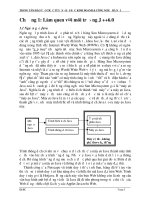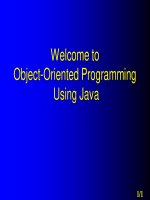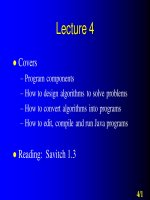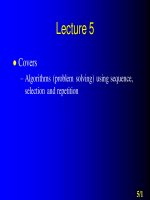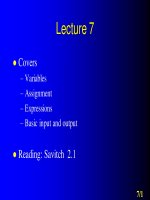Giáo trình Java cơ bản 07
Bạn đang xem bản rút gọn của tài liệu. Xem và tải ngay bản đầy đủ của tài liệu tại đây (537.34 KB, 39 trang )
Lecture 7
Covers
–
–
–
–
Variables
Assignment
Expressions
Basic input and output
Reading: Savitch 2.1
7/1
► Variables
7/2
Variables
A Java variable stores an item of data
Examples
– a number
– a boolean
– a character
The value of the data item may change as the
program executes
The value is stored in a memory location
The name of the variable is an alias for that
memory location within the program
7/3
Java program using variables
import java.util.*;
public class TemperatureConverter
{
public static void main(String[ ] args)
{
double tempInCelsius;
double tempInFahrenheit;
Scanner keyboard = new Scanner(System.in);
System.out.print("Enter a temperature in celsius: ");
tempInCelsius = keyboard.nextDouble( );
tempInFahrenheit = (tempInCelsius * 9) / 5 + 32;
System.out.print(tempInCelsius + " Celsius is equivalent to "
+ tempInFahrenheit);
}
}
7/4
Identifiers
Identifier = name of a class, a method, an attribute,
or a variable
Format
– Start with a letter or the underscore symbol
– Rest consists of letters, digits or underscore symbol
– Examples
sum, RATE, count, data2, Big_bonus, X_1
height, Height, HEIGHT, _height, bigBonus
– The dollar sign is also permitted but it is not a good
idea to use it as it is usually reserved for special
purposes
7/5
Identifiers
Convention
– Use only letters, starting with a lower case
letter, with words after the first one having an
initial capital
shoeSize
– This convention is sometimes referred to as
camelBack notation
Java is case sensitive, therefore it
distinguishes between uppercase and
lowercase letters in an identifier
7/6
Identifiers
Which of the following are valid identifiers?
X
x34
x*
34xyz
x_3_5
7/7
Keywords
Keywords or reserved words are those that
have special pre-defined meaning
Keywords cannot be used an identifier (in
particular, not as the name of a variable)
– Examples
int
if
else
7/8
Variable declarations
A variable’s type tells the compiler what sort of
information the variable can contain
The type of every variable must be declared before
the variable is used
We declare a variable by declaring its type,
followed by the variable name
int tempInCelsius;
double totalWeight;
Variables can also be initialised at declaration
(assign a value to it)
int tempInCelsius = 0;
double totalWeight = 0.07;
7/9
► Primitive data types
7/10
Primitive data types
Java has 8 primitive data types
–
–
–
–
–
–
–
–
byte
short
int
long
float
double
char
boolean
integers
numeric values
floating-point
characters
truth values
7/11
Integer data types
Integer types store whole numbers (both
positive and negative values)
4 types of integers in Java that store values
in different amounts of memory
The more memory they use, the larger the
range of values they can store
Use the int type (4 bytes) unless you have a
specific reason for using another type
7/12
Real number data types
Floating-point number types store numbers with
fractional parts
2 types of floating-point numbers in Java that store
values in different amounts of memory
Not all numbers can be stored exactly using floatingpoint representation
The more memory used, the larger the range of values
that can be stored, and the more precise they are
Use the double type (8 bytes) unless you have a
specific reason for using another type
7/13
► Assignment
7/14
Assignment
The assignment statement is used to set or
change the value of data stored by a
variable
– Examples
numberOfFriends = 3;
totalWeight = 34.5;
totalWeight = singleWeight * numberOfItems;
7/15
Assignment
An assignment statement has the form
<variable> = <expression>;
where the expression on the right is evaluated and
then the resulting value is assigned to (stored in)
the variable on the left
Example
area = width * height;
bottles = bottles - 1;
( = is called the assignment operator)
7/16
Literals
Each data type specifies a range of values
For each data type, we need to know how to
write its data values in a program
The explicit data values in programs are
called literals
For example
singleWeight = 5.0;
5.0 is a literal of the type double
7/17
► Operations on primitive
data types
7/18
Operators and operands
An operator operates on one or more
operands (arguments) and returns a value
– Most operators are binary operators (i.e. have
two operands)
– Some are unary operators (i.e. have one
operand)
– Some operate on more than two operands
7/19
Arithmetic expressions
Expressions may use arithmetic operators
The basic arithmetic operators are
+
addition
subtraction
*
multiplication
/
division
% remainder
7/20
Assignment
int a = 9;
int b = 6;
int c = 0, d = 12;
After
1.
2.
3.
4.
5.
b
c
a
c
b
=
=
=
=
=
a;
19 - b;
b - 10;
c - 2;
d * 2;
a
b
c
d
1.
2.
3.
4.
5.
7/21
► Input & output statements
7/22
Input/output
Input and output - used by a program for
external communication
Input
– Read into the program
Output
– Written out from the program
7/23
Output
System.out = standard output stream (monitor)
– Examples
System.out.print("I am a fish");
System.out.print(numberOfFriends);
System.out.print("I toast therefore I am " +
numberOfFriends);
7/24
Output
New lines
– Examples
System.out.print("I am a fish\n");
System.out.println("I am a fish");
System.out.print("I\nam\na\nfish\n");
7/25


